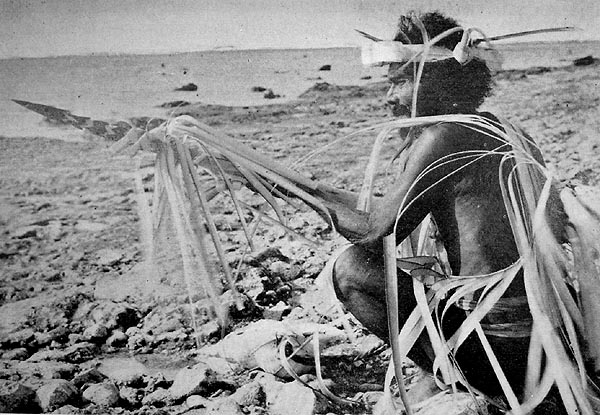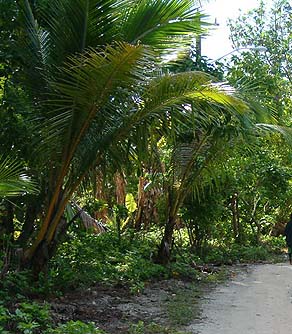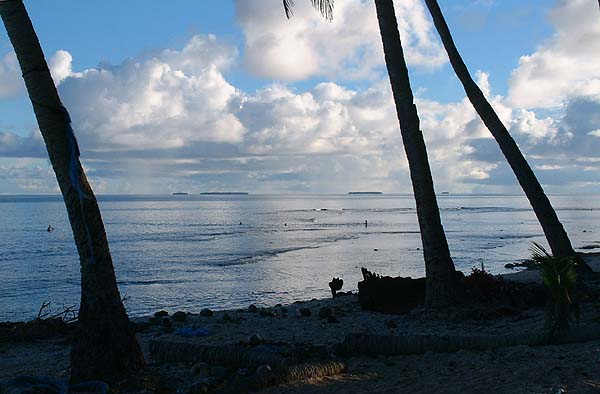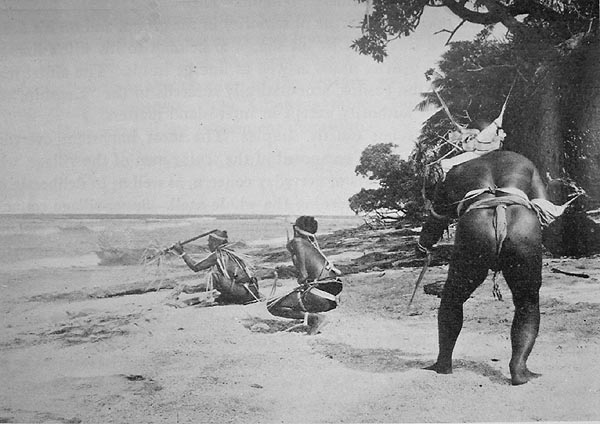| Traditional Religion:
|
“We have gods here and goddesses,” Cal explains, “it’s almost like in Greek mythology, where we have levels of gods, and some of them, when you think about it, they sort of resemble what the Old Testament is, but in all of the cases, it sort of a take-off on the old Greek Mythology, where you have the gods—gods of this, god of that, there are so many different gods. And in Ulithi also we have god of the sea, god of plants, the guardians of land, and so on and so forth. So those gods played a very important role in the cycle, living here, because they’re always being asked for forgiveness, they’re always prayed to for things.
|
||
|
|
||
“I know there used to be a lot of stories about those things. We have stories of certain places where certain things have come from, how things came to be. You know the young coconut leaves—the leaves of the young coconut trees? For some reason they always endlessly shaking vigorously and they make certain kind of sound because of the fibers, it sort of creates a noise. “And you’ll see the leaves shaking vigorously, and some people will say, ‘Oh, that’s the god—Yol’faaed is right there,’ because he’s considered to be the god of trickster, who is always kind of throwing things in the middle. If something is going well, he will put something there to be sort of throw if off, so he’s always tricking things. So when we see that, you know he’s so far ahead trying to figure out what he’s going to do next!”
|
|
“When I was growing up,” Alphonso says, “there were some people who still prayed to this Spirit, and according to the story, I do not know where he was from, but he was a human being, a child who died and then returned back as a spirit and helped people solve problems. His name was Marispa. And during the late Japanese Occupation here, the people who hadn’t joined the Catholic faith were still praying to him for guidance and everything. In fact, if they were going to eat, before they ate, they took a small piece and put it out for Marispa to guide us and care for us and so forth. And then they started eating.” “And they usually had small houses with coconut oil inside—bottles or containers—and they usually made leis and brought them there, and prayed. As far as their prayers, I do not know because I was almost born a Catholic, but I usually watched them doing this. Even during the War, World War II, close to the end, because that’s when they invaded our islands, there were some old people who, when the planes came, would say ‘Ohh, Marispa, please take care of us.’ And not only in Mogmog.” “He’s like the guardian of prosperity and good health,” Cal explains. “Every time there’s a death, or every time something happens, they always ask for his guidance. So, just like us when we pray for dinner or good health, that’s going be summoned to look after, so we have certain gods, certain levels of gods that supposedly have their respective jurisdictions that they look after.” “That’s very hard for us to know the real story,” Alphonso adds. “Because the only part, as I said before is that he was a child, died during the time that he was still young, and as far as from where he came from, or his parentage, that’s sort of taboo to talk about. So therefore it’s very hard for us to find out where it originates from, all those things.”
|
||
|
|
||
|
“A long time ago, I think it’s before the War, there was a place down there that the people used to go down and pray to their Spirit,” Hosay says. “They believed that there was a Spirit there that they wished to go and pray to. Bring small flowers, mwarmwar, and they there for the Spirit, and they put coconut oil in small containers there. Here on Mogmog, I think that’s the only such place. According to the story, it’s just before the Spanish arrived that this thing started, the place for the Spirit. It’s not really way, way back. “They continued this until during the War Then no more. Because during the Japanese time a lot of people here became Catholic and they didn’t believe in that kind of thing. The place is still there but that small house over there is gone.”
|
||
|
|
||
|
"Basically, it’s gone, other than what we have down on paper," Cal points out. "It’s no longer being worshiped, it’s no longer being told as a legends or anything. I’m trying to find a way to sort of present it in a Greek-mythology way, where it’s a story that is of historical value to the people, to the kids here. But then at this point, the information is not intact, it’s choppy, so we have to reconstruct it the best we can. There is perhaps a lot of missing information. "I have made a collection of the names of all of those gods, and there are hundreds of them for all the Yap Islands, all the way to Satawal. I’m trying to isolate the ones for Ulithi only, and there are quite a few of them. That’s why I say, it’s almost like the Greek gods and goddesses, because there are so many, in those kinds of hierarchal levels. “The gods were instrumental in many things,” Cal concludes. “According to the legends, some of those gods had something to do with the people who came down from heaven to earth and eventually, in the form of Filtey, came out here. These people were originally descendents of those gods from heaven, who came down to earth, and then made their habitat here. Then they eventually spread around to all of the islands throughout Micronesia.”
|
||
|
|
||
|
|||||
|
|||||




